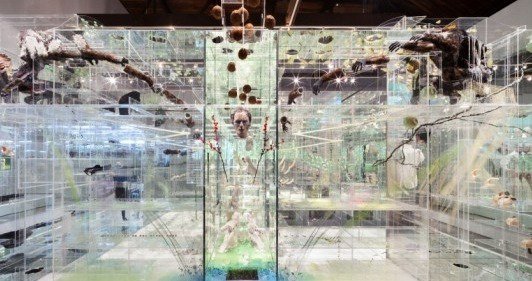Two Exhibitions
dal 19/6/2015 al 12/9/2015
Segnalato da
Musee d'art contemporain de Montreal
19/6/2015
Two Exhibitions
Musee d'art contemporain de Montreal MACM, Montreal
David Altmejd presents 'The Flux and the Puddle', brilliantly sums up the main motifs and concerns that fill Altmejd's remarkable,vigorous imagination. In Rafman's work there is a form of layered nostalgia that manifests itself through nods to high and low culture.

David Altmejd
The presentation at the Musée features some thirty works produced over the last fifteen
years, in addition to a new, site-specific piece. One of the key works in the show, The Flux and the
Puddle, 2014, brilliantly sums up the main motifs and concerns that fill Altmejd’s remarkable,
vigorous imagination.
His spectacular sculptures, meticulously crafted out of a wide assortment of components
and materials, draw on a hybrid, cumulative aesthetic to conjure up the powerful forces of
decay and regeneration, and to establish a metaphorical dialectic between the human world
and the animal realm.
Altmejd quickly earned a reputation for his baroque depictions of the enigmatic figure of
the werewolf, which constantly undergoes transformations. However, he does not offer stories
or scenarios but, rather, reveals inspired iterations of a unique spirit and sensibility, in tune
with the meanderings of a lucid dream.
Bringing together a minimalist structural rigour contrasted with unfolding fields of
energy, Altmejd recognizes the primacy of the conceptual approach in shaping the cycles that
run through his work: heads, constructed, architectural pieces, werewolves, bird men, giants,
bodybuilders, guides, watchmen... The abrupt changes in scale (from the minuscule to the
monumental), profusion of materials (crystals, mirrors, synthetic hair and fur, resin, wood,
metal) and the various devices he uses to occupy the space (platforms, display cases, oversized
cabinets) are all strategies that position the artist as a creator of all possibilities.
Universal in its scope, Altmejd’s work merges the self and the other in the constant,
repeated echo of the mirror image and the intensity of the primal, human, animal presence at
different moments in the cycle of life.
Born in Montréal in 1974, David Altmejd lives and works in New York. He represented
Canada at the 52nd Venice Biennale, in 2007, and won the Sobey Art Award in 2009. Other exhi
bitions include the 8th Istanbul Biennial, in 2003; New York’s Whitney Biennial, in 2004; and the
first Québec Triennial at the MACM, in 2008. Altmejd’s work may be found in the following col-
lections: Musée d’art contemporain de Montréal; National Gallery of Canada; Art Gallery of
Ontario; Montreal Museum of Fine Arts; Les Abattoirs, Toulouse; Solomon R. Guggenheim
Museum, New York; Whitney Museum of American Art, New York; MOCA – Museum of
Contemporary Art, Los Angeles; and MUDAM – Musée d’art moderne Grand-Duc Jean,
Luxembourg. He was recently made a companion of the Ordre des arts et des lettres du Québec.
This exhibition was organized by the Musée d’art moderne de la Ville de Paris / Paris Musées
and the Musée d’art contemporain de Montréal.
---
Jon Rafman
Jon Rafman (b. 1981) is a Montréal-born and based artist who, for his first major museum exhi
bition in Canada, has assembled a vast body of work in a variety of photographic works and
video installations. While this selection covers a relatively short period of time, it articulates
how as an artist he stands in for other archetypes such as the tour guide, the flâneur and the
ethnographer. The exhibition will also feature recent developments in the artist’s approach to
sculpture which, on many levels, bridges the gap between the virtual and the real.
Rafman’s rapidly evolving and diverse practice is not marked by clear-cut stages or peri
ods. Rather, he condenses many concerns into individual works, and varies the emphasis
accordingly. For example, the New Age Demanded series of images and sculptures exists simul-
taneously as an online catalogue, database or photoblog, and unique printed images and sculp-
tures that reference modernist poetry (the title of the series is taken from a poem by Ezra Pound)
and sculpture (the forms are evocative of Constantin Brancusi, Hans Arp and Henry Moore), as
well as classical statuary. They are symptomatic of so-called “post-studio” production means in
their application of digital manufacturing technologies (imaging software, 3D printing, com-
puterized milling). More importantly, though, Rafman’s use of these technological tools allows
the works to evoke a sense of futurity that is at once past (as related to modernist imagery) and
present (in their seductive techno-fetishistic finish), hence underlining our constantly
changing relationship to the future.
In Rafman’s work—especially in his videos—there is a form of layered nostalgia that
manifests itself through nods to high and low culture, such as Internet memes, art history and
video games, to name a few. Most of these works are presented here in DIY-crafted viewing
stations that reference both high-end design from the early 1980s and vernacular suburban
furniture from the sixties and/or seventies.
One of the major characteristics of the work in this survey, which is often associated with
online culture, is the way it allows viewers to rethink their relationship to technology. More
specifically, Rafman questions how it is that we, as a society, have established a new techno-
logical order based on a utopian ideal, only to then discredit any and all utopias as organizing
principles for our societies. Our over-reliance on—as well as fascination and disappointment
with—the Internet and the digital realm as potentially radically non-hierarchical democratic
spaces is at the heart of these works.
Image: David Altmejd, The Flux and the Puddle, 2014
Opening: 20 June 2015
Musée d'art contemporain de Montréal
185, rue Sainte-Catherine Ouest
Tue 11am to 6pm, Wed
Fri 11am to 6pm
Sat - Sun 10am to 6pm



